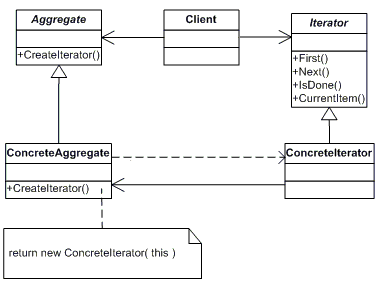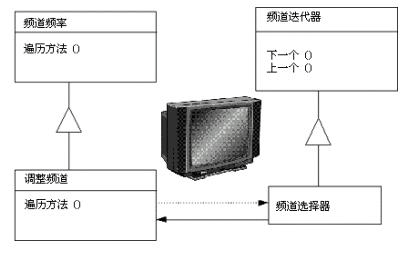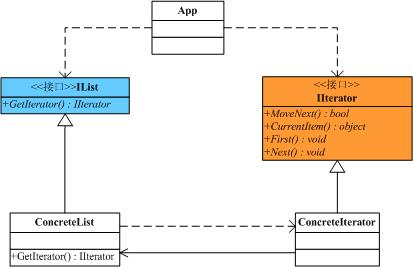第17章 迭代器模式(Iterator Pattern)
概述
在面向物件的軟體設計中,我們經常會遇到一類集合物件,這類集合物件的內部結構可能有著各種各樣的實現,但是歸結起來,無非有兩點是需要我們去關心的:一是集合內部的資料儲存結構,二是遍歷集合內部的資料。面向物件設計原則中有一條是類的單一職責原則,所以我們要儘可能的去分解這些職責,用不同的類去承擔不同的職責。Iterator模式就是分離了集合物件的遍歷行為,抽象出一個迭代器類來負責,這樣既可以做到不暴露集合的內部結構,又可讓外部程式碼透明的訪問集合內部的資料。
意圖
提供一種方法順序訪問一個聚合物件中各個元素, 而又不需暴露該物件的內部表示。[GOF 《設計模式》]
結構圖
Iterator模式結構圖如下:

圖1 Iterator模式結構圖
生活中的例子
迭代器提供一種方法順序訪問一個集合物件中各個元素,而又不需要暴露該物件的內部表示。在早期的電視機中,一個撥盤用來改變頻道。當改變頻道時,需要手工轉動撥盤移過每一個頻道,而不論這個頻道是否有訊號。現在的電視機,使用[後一個]和[前一個]按鈕。當按下[後一個]按鈕時,將切換到下一個預置的頻道。想象一下在陌生的城市中的旅店中看電視。當改變頻道時,重要的不是幾頻道,而是節目內容。如果對一個頻道的節目不感興趣,那麼可以換下一個頻道,而不需要知道它是幾頻道。

圖2 使用選頻器做例子的Iterator模式物件圖
Iterator模式解說
在面向物件的軟體設計中,我們經常會遇到一類集合物件,這類集合物件的內部結構可能有著各種各樣的實現,但是歸結起來,無非有兩點是需要我們去關心的:一是集合內部的資料儲存結構,二是遍歷集合內部的資料。面向物件設計原則中有一條是類的單一職責原則,所以我們要儘可能的去分解這些職責,用不同的類去承擔不同的職責。Iterator模式就是分離了集合物件的遍歷行為,抽象出一個迭代器類來負責,這樣既可以做到不暴露集合的內部結構,又可讓外部程式碼透明的訪問集合內部的資料。下面看一個簡單的示意性例子,類結構圖如下:

圖3 示例程式碼結構圖
首先有一個抽象的聚集,所謂的聚集就是就是資料的集合,可以迴圈去訪問它。它只有一個方法GetIterator()讓子類去實現,用來獲得一個迭代器物件。

 /**//// <summary>
/**//// <summary>
 /// 抽象聚集
/// 抽象聚集
 /// </summary>
/// </summary>
 public interface IList
public interface IList


 {
{ IIterator GetIterator();
IIterator GetIterator(); }
}
抽象的迭代器,它是用來訪問聚集的類,封裝了一些方法,用來把聚集中的資料按順序讀取出來。通常會有MoveNext()、CurrentItem()、Fisrt()、Next()等幾個方法讓子類去實現。

 /**//// <summary>
/**//// <summary>
 /// 抽象迭代器
/// 抽象迭代器
 /// </summary>
/// </summary>
 public interface IIterator
public interface IIterator

 {
{ bool MoveNext();
bool MoveNext();
 Object CurrentItem();
Object CurrentItem();
 void First();
void First();
 void Next();
void Next(); }
}
具體的聚集,它實現了抽象聚集中的唯一的方法,同時在裡面儲存了一組資料,這裡我們加上Length屬性和GetElement()方法是為了便於訪問聚集中的資料。

 /**//// <summary>
/**//// <summary>
 /// 具體聚集
/// 具體聚集
 /// </summary>
/// </summary>
 public class ConcreteList : IList
public class ConcreteList : IList

 {
{ int[] list;
int[] list;
 public ConcreteList()
public ConcreteList()


 {
{
 list = new int[]
list = new int[]  { 1,2,3,4,5};
{ 1,2,3,4,5}; }
}
 public IIterator GetIterator()
public IIterator GetIterator()


 {
{ return new ConcreteIterator(this);
return new ConcreteIterator(this); }
}
 public int Length
public int Length


 {
{
 get
get  { return list.Length; }
{ return list.Length; } }
}
 public int GetElement(int index)
public int GetElement(int index)


 {
{ return list[index];
return list[index]; }
} }
}
具體迭代器,實現了抽象迭代器中的四個方法,在它的建構函式中需要接受一個具體聚集型別的引數,在這裡面我們可以根據實際的情況去編寫不同的迭代方式。

 /**//// <summary>
/**//// <summary>
 /// 具體迭代器
/// 具體迭代器
 /// </summary>
/// </summary>
 public class ConcreteIterator : IIterator
public class ConcreteIterator : IIterator


 {
{ private ConcreteList list;
private ConcreteList list;
 private int index;
private int index;
 public ConcreteIterator(ConcreteList list)
public ConcreteIterator(ConcreteList list)


 {
{ this.list = list;
this.list = list;
 index = 0;
index = 0; }
}
 public bool MoveNext()
public bool MoveNext()


 {
{ if (index < list.Length)
if (index < list.Length)
 return true;
return true;
 else
else
 return false;
return false; }
}
 public Object CurrentItem()
public Object CurrentItem()


 {
{ return list.GetElement(index) ;
return list.GetElement(index) ; }
}
 public void First()
public void First()


 {
{ index = 0;
index = 0; }
}
 public void Next()
public void Next()


 {
{ if (index < list.Length)
if (index < list.Length)


 {
{ index++;
index++; }
} }
} }
}
簡單的客戶端程式呼叫:

 /**//// <summary>
/**//// <summary>
 /// 客戶端程式
/// 客戶端程式
 /// </summary>
/// </summary>
 class Program
class Program


 {
{ static void Main(string[] args)
static void Main(string[] args)


 {
{ IIterator iterator;
IIterator iterator;
 IList list = new ConcreteList();
IList list = new ConcreteList();
 iterator = list.GetIterator();
iterator = list.GetIterator();
 while (iterator.MoveNext())
while (iterator.MoveNext())


 {
{ int i = (int)iterator.CurrentItem();
int i = (int)iterator.CurrentItem(); Console.WriteLine(i.ToString());
Console.WriteLine(i.ToString());
 iterator.Next();
iterator.Next(); }
}
 Console.Read();
Console.Read();
 }
}
 }
}
一個簡單的迭代器示例就結束了,這裡我們並沒有利用任何的.NET特性,在C#中,實現Iterator模式已經不需要這麼麻煩了,已經C#語言本身就有一些特定的實現,下面會說到。
.NET中的Iterator模式
在.NET下實現Iterator模式,對於聚集介面和迭代器介面已經存在了,其中IEnumerator扮演的就是迭代器的角色,它的實現如下:
 public interface IEumerator
public interface IEumerator


 {
{ object Current
object Current

 {
{ get;
get; }
}
 bool MoveNext();
bool MoveNext();
 void Reset();
void Reset();
 }
}
屬性Current返回當前集合中的元素,Reset()方法恢復初始化指向的位置,MoveNext()方法返回值true表示迭代器成功前進到集合中的下一個元素,返回值false表示已經位於集合的末尾。能夠提供元素遍歷的集合物件,在.Net中都實現了IEnumerator介面。
IEnumerable則扮演的就是抽象聚集的角色,只有一個GetEnumerator()方法,如果集合物件需要具備跌代遍歷的功能,就必須實現該介面。
 public interface IEnumerable
public interface IEnumerable


 {
{ IEumerator GetEnumerator();
IEumerator GetEnumerator(); }
}
下面看一個在.NET1.1下的迭代器例子,Person類是一個可列舉的類。PersonsEnumerator類是一個列舉器類。這個例子來自於http://www.theserverside.net/,被我簡單的改造了一下。
 public class Persons : IEnumerable
public class Persons : IEnumerable 


 {
{  public string[] m_Names;
public string[] m_Names; 
 public Persons(params string[] Names)
public Persons(params string[] Names) 

 {
{  m_Names = new string[Names.Length];
m_Names = new string[Names.Length]; 
 Names.CopyTo(m_Names,0);
Names.CopyTo(m_Names,0);  }
} 
 private string this[int index]
private string this[int index] 

 {
{  get
get 

 {
{  return m_Names[index];
return m_Names[index];  }
} 
 set
set 

 {
{  m_Names[index] = value;
m_Names[index] = value;  }
}  }
}
 public IEnumerator GetEnumerator()
public IEnumerator GetEnumerator()

 {
{ return new PersonsEnumerator(this);
return new PersonsEnumerator(this); }
} }
}

 public class PersonsEnumerator : IEnumerator
public class PersonsEnumerator : IEnumerator

 {
{ private int index = -1;
private int index = -1;
 private Persons P;
private Persons P;
 public PersonsEnumerator(Persons P)
public PersonsEnumerator(Persons P)

 {
{ this.P = P;
this.P = P; }
}
 public bool MoveNext()
public bool MoveNext()

 {
{ index++;
index++;
 return index < P.m_Names.Length;
return index < P.m_Names.Length; }
}
 public void Reset()
public void Reset()

 {
{ index = -1;
index = -1; }
}
 public object Current
public object Current

 {
{ get
get


 {
{ return P.m_Names[index];
return P.m_Names[index]; }
} }
} }
}
來看客戶端程式碼的呼叫:
 class Program
class Program 

 {
{  static void Main(string[] args)
static void Main(string[] args) 

 {
{  Persons arrPersons = new Persons("Michel","Christine","Mathieu","Julien");
Persons arrPersons = new Persons("Michel","Christine","Mathieu","Julien"); 
 foreach (string s in arrPersons)
foreach (string s in arrPersons) 


 {
{  Console.WriteLine(s);
Console.WriteLine(s);  }
}
 Console.ReadLine();
Console.ReadLine();  }
}  }
}
程式將輸出:
 Michel
Michel 
 Christine
Christine 
 Mathieu
Mathieu 
 Julien
Julien
現在我們分析編譯器在執行foreach語句時到底做了什麼,它執行的程式碼大致如下:
 class Program
class Program 


 {
{  static void Main(string[] args)
static void Main(string[] args) 

 {
{  Persons arrPersons = new Persons("Michel","Christine","Mathieu","Julien");
Persons arrPersons = new Persons("Michel","Christine","Mathieu","Julien"); 
 IEnumerator e = arrPersons.GetEnumerator();
IEnumerator e = arrPersons.GetEnumerator(); 
 while (e.MoveNext())
while (e.MoveNext()) 

 {
{  Console.WriteLine((string)e.Current);
Console.WriteLine((string)e.Current); 
 }
}
 Console.ReadLine();
Console.ReadLine(); }
}  }
}
可以看到這段程式碼跟我們最前面提到的示例程式碼非常的相似。同時在這個例子中,我們把大部分的精力都花在了實現迭代器和可迭代的類上面,在.NET2.0下面,由於有了yield return關鍵字,實現起來將更加的簡單優雅。下面我們把剛才的例子在2.0下重新實現一遍:
 public class Persons : IEnumerable
public class Persons : IEnumerable 

 {
{  string[] m_Names;
string[] m_Names; 

